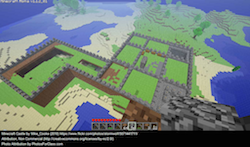1.1 Read About a Sense of Place
1.1B Words Create Worlds
 When you are exploring language, think of each word like a Minecraft block. Words are building blocks author's use to help readers understand their worlds - to develop a sense of place.
When you are exploring language, think of each word like a Minecraft block. Words are building blocks author's use to help readers understand their worlds - to develop a sense of place.
To be a top-notch builder, you should know about the tools and materials you are working with.
Learn about some parts of speech (nouns, pronouns, adjectives, verbs, and adverbs) and how they can be used to help build worlds with words!.
1. NOUNS: Nouns are easy to identify. A noun is a person, place, thing, or idea – and that’s what you are describing in descriptive text.
 |
In your Learning Guide, complete the activity titled, 1.1B Properly Print Proper Nouns. |
2. PRONOUNS:
A pronoun can be used instead of a noun.
Examples: I, you, he, she, it, we, they
 |
In your Learning Guide, complete the activity titled, 1.1B Keep an Eye on Pronoun Use. |
3. ADJECTIVES:
An adjective describes a noun or pronoun. It helps build a stronger picture of the person, place, or thing in the reader’s mind.
golden compass Halq'eméylem language
bright-eyed owl electric wheelchair
Adjectives are often right before a noun (but not always), and they are usually after the verb to be when describing a pronoun.
Examples:
- The pottery is fragile. (fragile describes the noun pottery.)
- It is fragile. (fragile describes the pronoun it.)
 |
In your Learning Guide, complete the activity titled, Adjective Riddle Challenge. |
4. VERBS:
Think of a verb as the engine that makes a sentence go. Verbs help take your readers on an exciting ride. A verb is an action or a state of being. Action verbs are say to find. The state of being verbs (is, are, was, were) is trickier.
EXAMPLES:
- The driver slammed on the break, and the car screeched to a stop.
- The students jumped up and down, hurled their caps in the air, whooped with joy, and hugged each other.
- I am a dinosaur fan.
Every complete sentence has either a noun or a pronoun and a verb.
5. ADVERBS:
An adverb describes a verb or another adverb. It tells you how something is done. It can also tell you when or where something happened. Adverbs often end in –ly.
Example: The orca whale dove quickly after the fish. (adverb quickly describes the verb dove)
Example: The orca whale dove very quickly after the fish. (adverb very describes the adverb quickly)
Example: Nyall is travelling to Kamloops tomorrow. (adverb tells you when Nyall is travelling)
Example: All the answers you need are here. (adverb tells you where the answers are)
 |
In your Learning Guide, complete the activity titled, Help the Weak Sentences. Then complete the "1.1B Parts of Speech Quiz". |